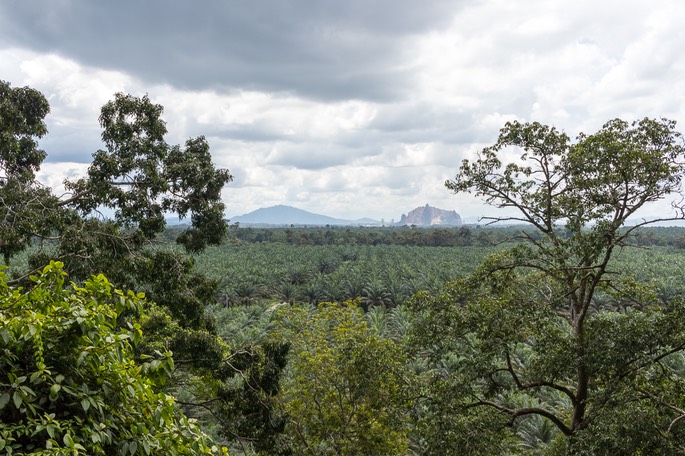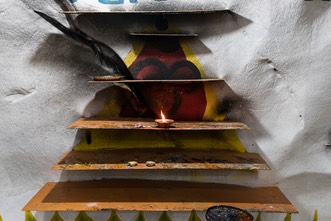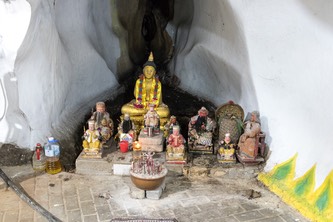
Kuantan is the state capital of Pahang, and the largest city on the east coast. In the first century it was part of the Chih-Tu empire; in the 11th century it was conquered by a small empire called Pheng-Kheng; in the 12th century it was taken over by the Siamese; and in the 15th century it was part of the Melakan Empire. By the end of the 19th century, Pahang saw the arrival of Chinese tin miners and traders, then rubber plantations attracted Indian settlers as well.
Today’s plan was to travel inland from Kuantan and visit the Sungai Lembing Tin Mines and the Gua Charas - Sivan Temple.

When you travel with Malaysians, everything is about food! So we started Day 2 at a local kopitiam (Kemaman Kopitiam) for a leisurely breakfast. My poison is French toast with peanut butter, honey, and butter; delicious! My friends preferred a savoury start to the day with a fair quota of fried food. I must say that you are spoilt for choice in Kuantan when it comes to dining, as there are so many options.
Our first destination today was the Sungai Lembing Tin Mines, located about an hour's drive west into the hills. The countryside was lush and green but one could not stop to take photos as the roads did not allow it.

It turned out that both cars went the wrong way up a windy single track road to the top of the hill for the mines, so a good thing it was not busy! After we had signed in and had our temperatures taken, I didn’t even notice the ticket counter, so this caused much confusion when I went to pay on the way out. There is a shop here where you can buy souvenirs and drinks, and a welcome toilet! Then you head towards this rusty ‘train’ which takes you into the mine; it’s a one way journey as you have to walk out of the mine yourself.


It is easy to walk in the tunnels here but do bring a torch, or make sure your phone is well-charged, as many of the lights above the information panels may not be working.

Here you will learn that in 1888-1906, Sultan Ahmad Al-Mu’adzam Shah of Pahang granted an 80-year tin mining concession to the English-controlled Pahang Corporation. Ownership changed over the years until 2005 when the area was reclaimed by the government. Of course when mining first started, the complete isolation and inhospitable journey made life here tough. So this area developed as a self-sustaining mining town provided with roads, free electricity, water, dwellings, schools, and healthcare. They even had a duty-free shop. This area was known as the Eldorado of the East. If you said you came from Sungai Lembing, you were considered ‘cool’; this was the the place to be! When the Japanese invaded in 1941, the British flooded the mines and opened up the shops so everyone could grab the goods before the Japanese arrived.

Sungai Lembing has the largest network of underground tin mines in the world; their combined length would be 322 km which is more than the distance from Kuantan to Kuala Lumpur. As a visitor, you only get to see a fraction of this extensive mine, but it’s not too difficult to imagine the hardship of actually working in here.
As we were walking in the mines, we kept seeing these uniformed guys marching past us, and it turned out they were on a Civil Defence exercise. There were about 20 ‘bodies’ hidden in the mine area beyond where visitors are allowed, and it was the job of these guys to find and rescue them.


We all enjoyed exploring the mines and greatly appreciated a cold drink afterwards! There’s a large carpark here and everything a visitor needs, so I would definitely recommend a visit here if you are staying in Kuantan and need a change from the beach.
You can learn more about the history of the tin mining operations in Pahang by reading Lawrence’s blog in Travels with my wife (Day 2 of the Road Trip).

Not far from here is Gua Charas, which is a temple cave in a limestone hill known as Bukit Charas which is believed to be 400 million years old. The cave is a holy site for both Hindus and Buddhists.
You can see this limestone outcrop for miles; it will be on your righthandside as you drive from Kuantan to the Sungai Lembing Tin Mines. According to the Gua Charas - Sivan Temple website, the cave was closed because of the RMCO, but the warden let us in for a small donation. You can see in the photo below that the site could do with an influx of funds. Let me point out the arrows on the floor…. despite the relative lack of infrastructure here, the temple was following all the required SOPs and guiding visitors through the complex to maintain social distancing.

You need to walk up a scary metal staircase to get to the entrance to the cave, but the views here make it all worthwhile. You can see that this is not the only outcrop in the otherwise flat landscape.

You follow the signs and enter an enormous cave, looking like the den of a James Bond villain! In the photo below, you should be able to see a painted laying Buddha on the right, but you have to walk much further into the cave to the main Buddha. You will also find a very lonely-looking Indian religious man waiting for a worshipper to come and talk to him.








We were all very pleased that we had been able to visit this cave. Be prepared to pay a parking fee before you leave, but these costs are minimal when you think of the experience you have just enjoyed.
Thank goodness for cars with aircons! After cooling down, we drove back to Kuantan to the Berjaya Megamall and luckily found a digital store selling external hard drives. Our plan to make a 5-minute video every day was going to take up far more storage space than on my old laptop. Back at the hotel, Lawrence took his drone to the beach because it was off this coast that HMS Prince of Wales and HMS Repulse were sunk by the Japanese on 10th December 1941. This threw the British resistance into chaos and allowed the Japanese to come ashore along the east coast without anything to stop them. You cannot see these wrecks from above, but coastal shots definitely benefit from a bit of drone footage.

As we hadn’t eaten much today, we were really looking forward to dinner. Tonight it was an Asian/Western-style meal sitting outside at Chef’z, which wasn’t too far from the hotel. I think that Lawrence ended up with the best meal of the night!


Here is a slide show of the photos taken on Day 2:
Click here to return to The Great Malaysian Road Trip.
Click here to read Lawrence Gray’s account of some Tin Mining and the Chinese.
Click here to return to Travels in Malaysia 2020.
Click here to return to Helen Gray’s homepage.